Why Prioritize Nutrition for Top Alpaca Fiber?
You should prioritize nutrition because it directly impacts your alpacas’ fiber quality, softness, and overall value. Proper feeding supports healthy fiber follicles and maintains ideal micron counts for finer fleece. Balanced diets rich in protein, vitamins, minerals, and omega-3s enhance softness and luster, especially during pregnancy and growth stages. Avoid common feeding mistakes like overfeeding or underfeeding, as these harm fiber traits. Understanding these factors will help you manage and improve your alpacas’ fleece over time.
Key Takeaways
- Proper nutrition enhances fiber fineness, density, and luster by supporting healthy fiber follicle development in alpacas.
- Balanced diets with adequate protein, vitamins, and minerals are crucial for maintaining consistent, high-quality fleece production.
- Omega-3 fatty acids and antioxidant-rich feeds improve softness and overall fiber appearance.
- Avoiding overfeeding prevents coarser fibers and maintains optimal micron diameter for superior fiber quality.
- Tailored nutrition during pregnancy and lactation supports both dam and cria fleece development, ensuring long-term fiber excellence.
The Role of Nutrition in Alpaca Fiber Quality
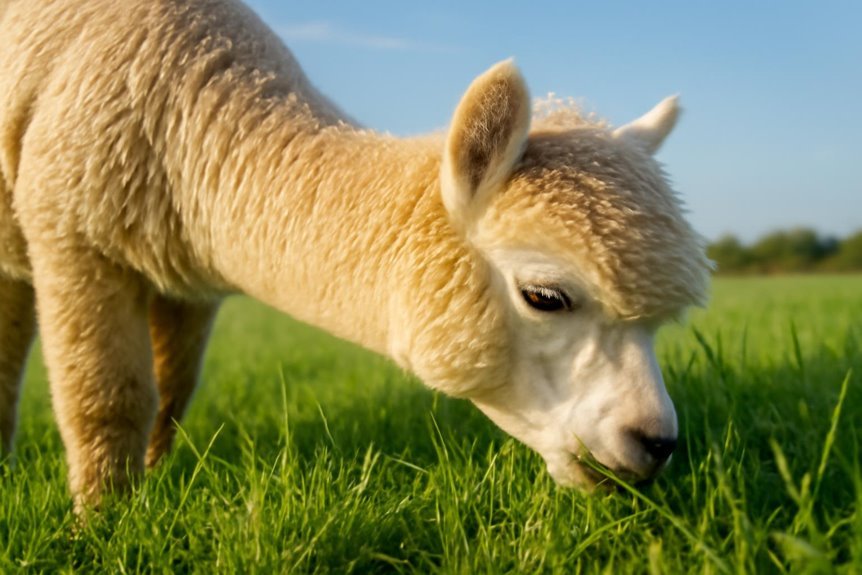
Because nutrition directly influences the development and health of fiber follicles, your alpacas’ diet plays an essential role in determining the fineness, density, and luster of their fleece. Proper nutrition is essential for healthy alpaca fiber development, especially in pregnant females, as it affects both their fleece and that of their cria. Feeding high-quality hay supplemented with balanced protein and minerals supports peak fleece quality and overall health. Using research-backed feeds like Mazuri can enhance fiber characteristics while reducing the need for extra supplements. You’ll want to avoid overfeeding or unbalanced diets, as these can lead to coarser fiber and duller fleece. Regularly monitoring fleece quality helps you adjust nutrition to maintain the finest, densest, and most lustrous alpaca fiber possible.
Understanding Alpaca Digestive Physiology
While alpacas might seem similar to other ruminants, their unique three-chambered stomach—consisting of the rumen, reticulum, and omasum—sets them apart in how they digest fibrous plant material. The rumen plays an essential role in fermentation, housing microbes that break down complex fibers crucial for proper digestion. To support this microbial health, you need to provide your alpaca with a balanced diet rich in high-quality feed, ensuring consistent intake of fiber. This digestive physiology directly influences fiber quality and fleece softness, as nutrients extracted during digestion fuel healthy growth. Remember, gradual diet changes help maintain microbial balance, preventing digestive upsets. Understanding this system is key to optimizing your alpaca’s nutrition and achieving top-tier fleece characteristics through proper digestive support.
Essential Nutrients for Optimal Fleece Production
To achieve the best fleece quality, you need to provide your alpacas with a balanced diet rich in protein, vitamins, and minerals, as these nutrients directly affect fiber fineness and density. Essential nutrients like omega-3 fatty acids enhance softness and luster, boosting overall fleece quality. Focus on these key nutrition elements:
Balanced diets rich in protein, vitamins, minerals, and omega-3s are key to superior alpaca fleece quality.
- Fresh, nutrient-rich forage combined with proper mineral supplementation prevents deficiencies that harm fleece and health.
- Higher protein and energy levels during pregnancy support cria development and future fiber quality.
- Tailoring diets to life stages—crias, pregnant, and older alpacas—ensures ideal nutrient intake for consistent fleece production.
Common Feeding Mistakes Affecting Fiber Characteristics
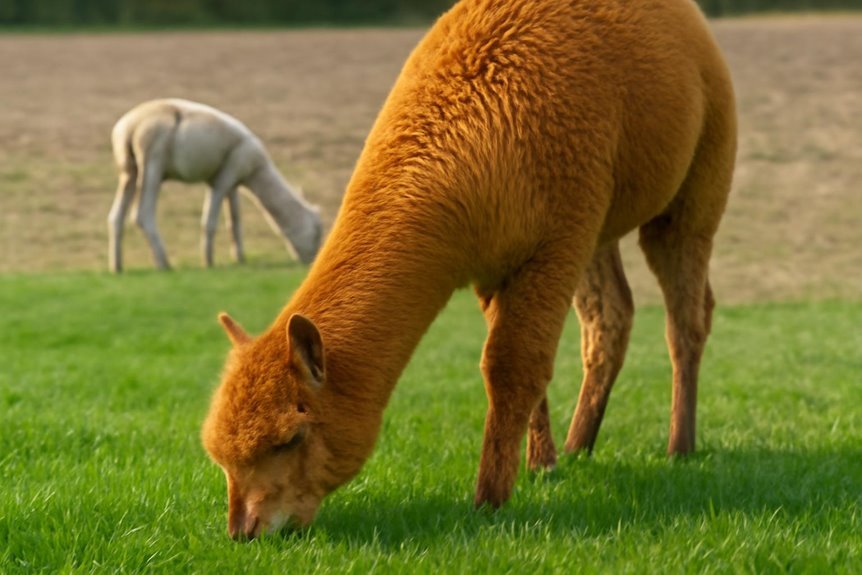
If you overfeed your alpacas, their fleece can become coarse and lose the softness needed for high-quality fiber. On the other hand, underfeeding leads to nutrient deficiencies that reduce fiber density and fineness. Balancing their diet carefully is key to maintaining excellent fleece characteristics.
Overfeeding Effects on Fiber
Because overfeeding alpacas disrupts their natural fiber production, you can end up with coarser, less desirable fleece. When you overfeed, the excess nutrition raises the micron count, which reduces softness and harms fiber quality. Plus, too much feed often leads to unhealthy weight gain, causing stress and health issues that further degrade fleece characteristics. To keep your alpacas producing high-quality fiber for soft alpaca garments, consider these key points:
- Monitor body condition regularly to avoid overfeeding and maintain ideal micron diameter.
- Provide balanced feeds designed to support healthy fiber growth without excess calories.
- Adjust nutrition based on individual needs to prevent negative impacts on fiber quality and animal health.
Underfeeding Consequences on Quality
When alpacas don’t get enough nutrients, their fiber quality can suffer considerably. Underfeeding leads to nutritional deficiencies that directly impact fiber characteristics, such as staple length, micron count, and fleece brightness. Low protein intake during key growth phases results in coarser fiber, while insufficient energy in the diet impairs fiber follicle development, reducing fleece density and uniformity. A lack of essential vitamins dulls the fleece, decreasing its luster and overall fleece quality. This not only affects your alpacas’ health but also lowers their market value. To avoid these issues, you need to prioritize monitoring body condition regularly and adjust feeding accordingly. Ensuring balanced nutrition helps maintain ideal fiber traits and supports both your alpacas’ well-being and the profitability of your fiber production.
Nutritional Needs at Different Alpaca Life Stages
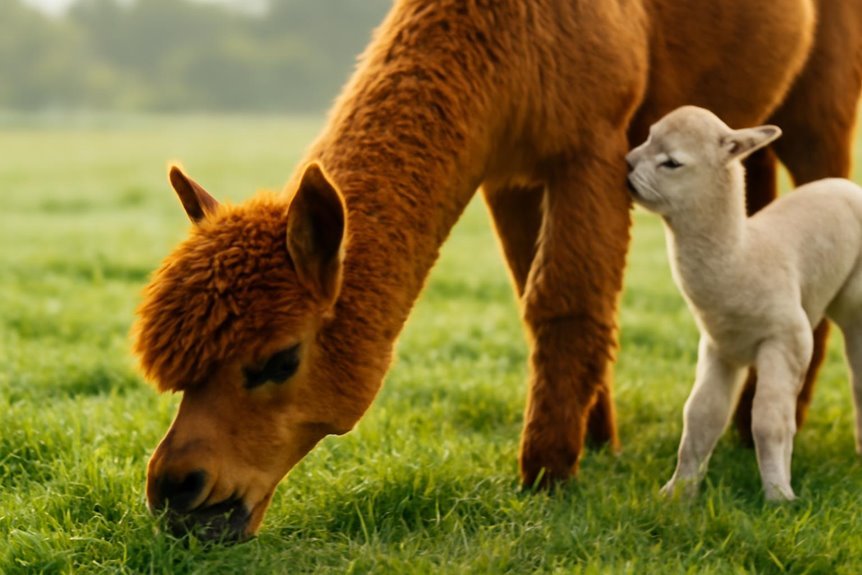
Although alpacas share many dietary needs, their nutritional requirements change considerably throughout their lives. To guarantee high-quality fiber production, you need to tailor their diet to each life stage.
Alpacas require diet adjustments at each life stage to ensure optimal fiber quality and health.
- Crias require a nutrient-rich diet rich in protein, vitamins, and minerals to support rapid growth and healthy fiber follicles.
- Pregnant alpacas need increased energy and protein for proper fetal development and maternal health.
- Older alpacas benefit from easily digestible forages and added nutrients to address age-related deficiencies.
Maintaining a well-balanced diet throughout all stages is essential for ideal body condition and fleece quality. By monitoring dietary intake and adjusting based on life stage needs, you can prevent digestive issues and promote consistent, high-quality fiber production.
Developing a Balanced Feeding Program
To develop a balanced feeding program, you need to understand your alpacas’ nutrient requirements and manage feed quality carefully. High-quality forage and proper supplements play a key role in supporting healthy fiber growth. Regularly testing your feed and adjusting rations guarantees your alpacas get exactly what they need for ideal fleece results.
Nutrient Requirements Overview
Because your alpacas’ fleece quality depends heavily on their nutrition, developing a balanced feeding program is essential. To meet their nutrient requirements, focus on these key elements:
- Provide at least 1.5% of their body weight daily in fresh, high-quality forage to support fiber growth and overall health.
- Include protein-rich feeds and essential nutrients like vitamins and omega-3s to enhance the softness, luster, and density of their fleece.
- Use targeted supplementation such as Mazuri, which contains selenium and vitamin E, to offer antioxidant support and further improve fleece quality.
Feed Quality Management
Every alpaca’s health and fleece quality hinges on the quality of their feed, making careful management vital. You need to base your nutrition program on high-quality forage that supports peak digestion with a high-fiber, low-starch profile. Testing hay and pasture helps you spot nutrient deficiencies early, so you can provide tailored supplementation with products like Mazuri feeds. It’s essential to monitor intake carefully—overfeeding or underfeeding can harm fleece quality. Feeding at least 1.5% of body weight daily, split into two meals, stabilizes digestion and nutrient absorption. Don’t forget vitamin D, especially if your alpacas get limited sunlight, as it’s important for bone health. By balancing these factors, you’ll guarantee your alpacas maintain strong health and produce top-quality fiber.
Monitoring Changes in Fleece Quality Through Diet
When you regularly inspect your alpaca’s fleece—checking micron counts, staple length, and density—you’ll catch subtle changes that reveal how diet affects fiber quality. Monitoring fleece quality is crucial to link nutrition adjustments with fiber health improvements. Focus on these key steps:
- Use micron testing alongside evaluations of staple length and density to detect shifts caused by diet changes.
- Adjust protein content and vitamin and mineral intake to support high-quality fiber development.
- Avoid overfeeding or poor feed choices that can lead to coarser fibers and dull appearance.
Consistent feeding with high-quality hay maintains ideal fleece characteristics. By carefully tracking these indicators, you can fine-tune your alpaca’s diet to guarantee the best fiber quality possible.
Benefits of Specialized Alpaca Feed Formulations
Although you can manage your alpaca’s nutrition with basic feed, specialized formulations are specifically designed to meet their unique needs, boosting both health and fleece quality. Using specialized alpaca feed guarantees your animals receive balanced protein, vitamins and minerals critical for peak health and ideal fiber production. These high-quality feeds often include added selenium and vitamin E, enhancing antioxidant support and improving fleece quality. Formulations tailored for pregnant or lactating females provide extra energy and nutrients, promoting healthy growth in crias. Regular feeding supports a balanced rumen microbial population, which is essential for effective nutrient absorption and digestion. By relying on specialized feeds, you reduce the need for extra supplements, streamlining care and helping your alpacas consistently produce top-quality fiber.
Frequently Asked Questions
When Would an Alpaca Require Extra Nutrition Depending on Their Different Stages?
You’ll need to nourish alpacas extra during breeding season, gestation period, lactation phase, and growth stages. Also, watch for stress factors, health issues, aging alpacas, environmental conditions, fiber production, and the weaning process for peak care.
What Is Unique About Alpaca Fiber?
You’ll love alpaca fiber for its luxurious softness, lightweight warmth, and natural insulation. It’s hypoallergenic, moisture-wicking, offers vibrant color variety, boasts high tensile strength, and supports sustainable fiber production through ethical farming with low environmental impact.
What Nutrients Do Alpacas Need?
Did you know alpacas need 14-16% protein? For ideal fiber quality, you must focus on alpaca nutrition by balancing essential vitamins, mineral requirements, dietary sources, hydration, and feeding strategies to support growth stages and digestive health.
Why Are Alpacas Considered to Be More Efficient Digesters of Food Compared to Sheep and Cattle?
You’ll find alpacas’ digestive efficiency owes to unique rumen development, microbial fermentation, and digestive enzymes. Their anatomy and grazing habits boost nutrient absorption and feed conversion, supporting fiber production—so smart feeding strategies maximize these advantages.

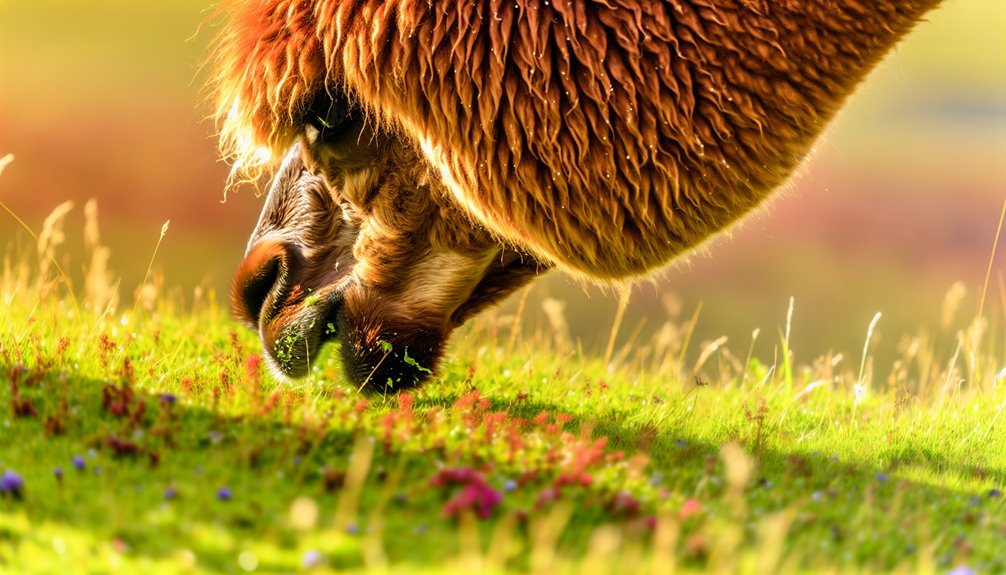

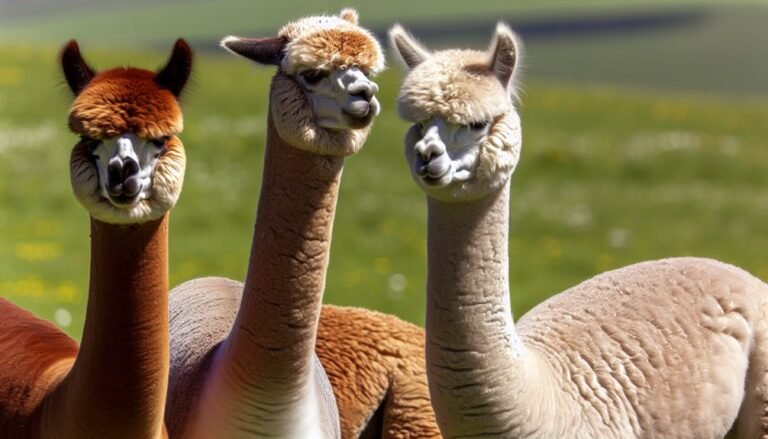
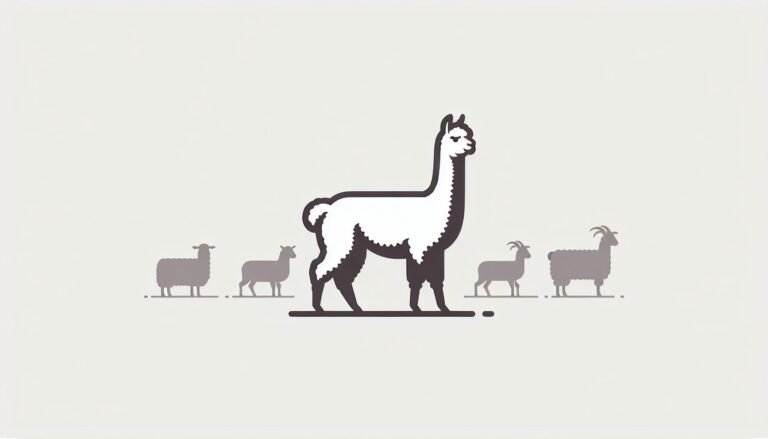
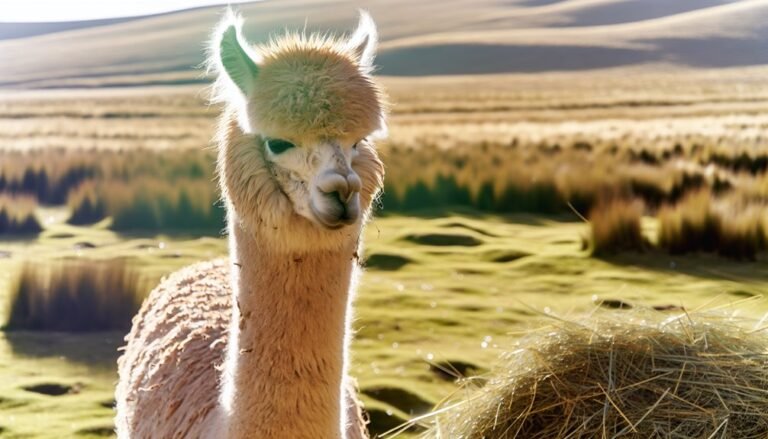

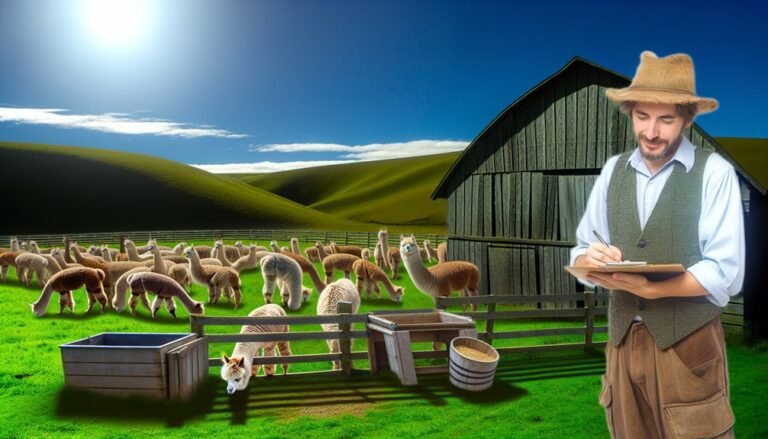
Our picks
Alpaca & Wool Felted Sole Inserts: Comfy Upgrade?
Best Alpaca Socks for Hiking: Ultimate Comfort and Durability on Trails
Best Alpaca Halter for Comfort and Control